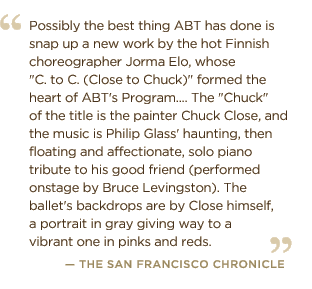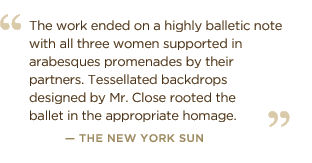

Masterworks and Edgy Ventures at American Ballet Theatre
excerpt from The Village Voiceby Deborah Jowitt November 5th, 2007
ABT also offered two new ballets this fall - one by the in-demand Finnish choreographer, Jorma Elo.... Elo's C. to C. is calm compared to other Elo ballets. The initials in the title stand for "Close to Chuck," and the score is Philip Glass's A Musical Portrait of Chuck Close (elegantly played for the ballet by Bruce Levingston). The painter and the composer have indeed been close friends for many years. I'd have to hear Glass's music by itself to see if I could discern Close's personna in the music, but, just as Close's best-known works atomize portraits by assembling his subjects' faces via small, vibrantly painted diamond shapes, Glass's music is built of tiny units that repeat and expand to create a large picture. Elo, of course, is Mr. Fragmentation.
The ballet is divided into two halves; two different Close self-portraits (themselves atomized or truncated by being presented in extreme closeup) succeed one another as backdrops. One is in black-and-white, the other vibrantly colored. A black curtain that drops briefly during the transition may perhaps mark a turning point in Close's career and private life: the moment when an accident caused severe spinal damage and confined him to a wheelchair. C. to C. is full of moments that invite deciphering. When Sascha Radetsky, standing bare-backed under a harsh beam of light, ripples and contorts his spine in remarkable and disturbing ways, we think of Close. But it?s hard to know what Elo has in mind when Radetsky, standing beside Riccetto, reaches down to scoop up an imaginary substance. Levingston, seated at the onstage instrument, also has his back turned to us, so that Glass?s score ripples out without obvious effort on the pianist?s part. Nor is it easy to fathom why three of the ballet?s six dancers initially wear black cloaks. Ralph Rucci?s gorgeous costumes are themselves enigmatic. At first Riccetto and Radestsky, Reyes and Salstein, Stella Abrera and Hoven wear long, full, stiff, black silk skirts that flare open in the back to reveal colored lining (the men are bare-chested). They discard these after a while for trimmer attire that makes it easier for them to flings their legs about.
A passage in which Salstein and Reyes move their limbs stiffly may or may not refer to Close?s physical difficulties, but surely the emphasis on posing in other sections refers to the process of portraiture. Throughout, the movement looks broken up, disjointed, kinky - bright bolts that twist and shatter before they reach what might be considered a conclusion.







